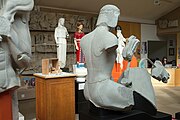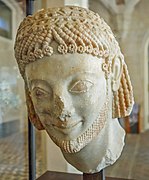art.wikisort.org - Sculpture
The Rampin Rider or Rampin Horseman (c. 550 BC) is an equestrian statue from the Archaic Period of Ancient Greece. The statue was masterfully made of marble and has traces of red and black paint.

The head of the rider was found on the Acropolis of Athens in 1877 and donated to the Louvre. Parts of the body of the rider and horse were found ten years earlier in a Perserschutt ditch filled with statues broken during the 480 BC Persian sack of Athens. The head was not associated with the rest of the statue until 1936. The statue is displayed with a plaster cast of the head at the Acropolis Museum, while the head remains at the Louvre where it is displayed with a cast of the rest of the statue.
The rider has many of the features typical of an Archaic kouros, but has several asymmetrical features that break with the period's conventions.
Interpretations
The statue was originally thought to be a part of a set of statues, perhaps paired with another as a mounted presentation of Castor and Pollux common on vases from this period. According to another theory, the statue represents the winner of a race. This theory is supported by the crown of lovage, given to winners of the Nemean Games and the Isthmian Games, on the statue.
Gallery
- Rear view of a cast at the Museum of Classical Archaeology, Cambridge
- Original of the head, in the Louvre Museum
- Reconstitution with plaster-cast body, Louvre Museum
References
На других языках
[de] Reiter Rampin
Der Reiter Rampin ist ein in Fragmenten erhaltenes, archaisches Reiterstandbild aus Inselmarmor von der Athener Akropolis. Der namengebende Kopf Rampin wurde 1877 auf der Akropolis gefunden und von dem französischen Botschaftssekretär in Athen, Georges Rampin, für seine Sammlung erworben. Im Jahr 1896 vermachte er den 27 Zentimeter hohen Kopf dem Louvre in Paris, wo er unter der Inventarnummer 3104 ausgestellt wird. Im Jahr 1886 wurde westlich des Erechtheions bei der Untersuchung des Perserschutts auf der Akropolis der unvollständige und in mehrere Fragmente gebrochene Torso samt Ansatz des Pferdekörpers gefunden, der sich unter der Inventarnummer 590 im Akropolismuseum befindet. Seine Höhe beträgt 81,5 Zentimeter. Im Jahr 1935 erkannte Humfry Payne die Zusammengehörigkeit beider Funde, die er mit Hilfe eines Gipsabgusses des Kopfes in Athen überprüfte. Das Ergebnis publizierte er 1936. Der Reiter Rampin wurde um 550 v. Chr. von einem unbekannten, aber herausragenden Künstler geschaffen, der heute den Notnamen Rampin-Meister trägt. Auftraggeber und Anlass der Aufstellung sind unbekannt.- [en] Rampin Rider
[es] Jinete Rampin
El Jinete Rampin, también llamado Caballero Rampin, es una escultura tipo kuros que data de mediados del siglo VI a. C. y que fue esculpida por un artista de los talleres de Ática. Se trata de la escultura de un hombre a caballo más antigua del arte y una de las obras maestras pertenecientes al Período arcaico de Grecia.[it] Cavaliere Rampin
Il Cavaliere Rampin è una statua equestre arcaica in marmo, alta circa 123 cm e divisa in due pezzi: corpo e resti del cavallo (h 110,5 cm) si trovano nel Museo dell'Acropoli ad Atene, la testa (che ad Atene è un calco) si trova invece nel Louvre di Parigi. È l'unico esempio conservato di scultura equestre dell'arte greca arcaica.Другой контент может иметь иную лицензию. Перед использованием материалов сайта WikiSort.org внимательно изучите правила лицензирования конкретных элементов наполнения сайта.
WikiSort.org - проект по пересортировке и дополнению контента Википедии


